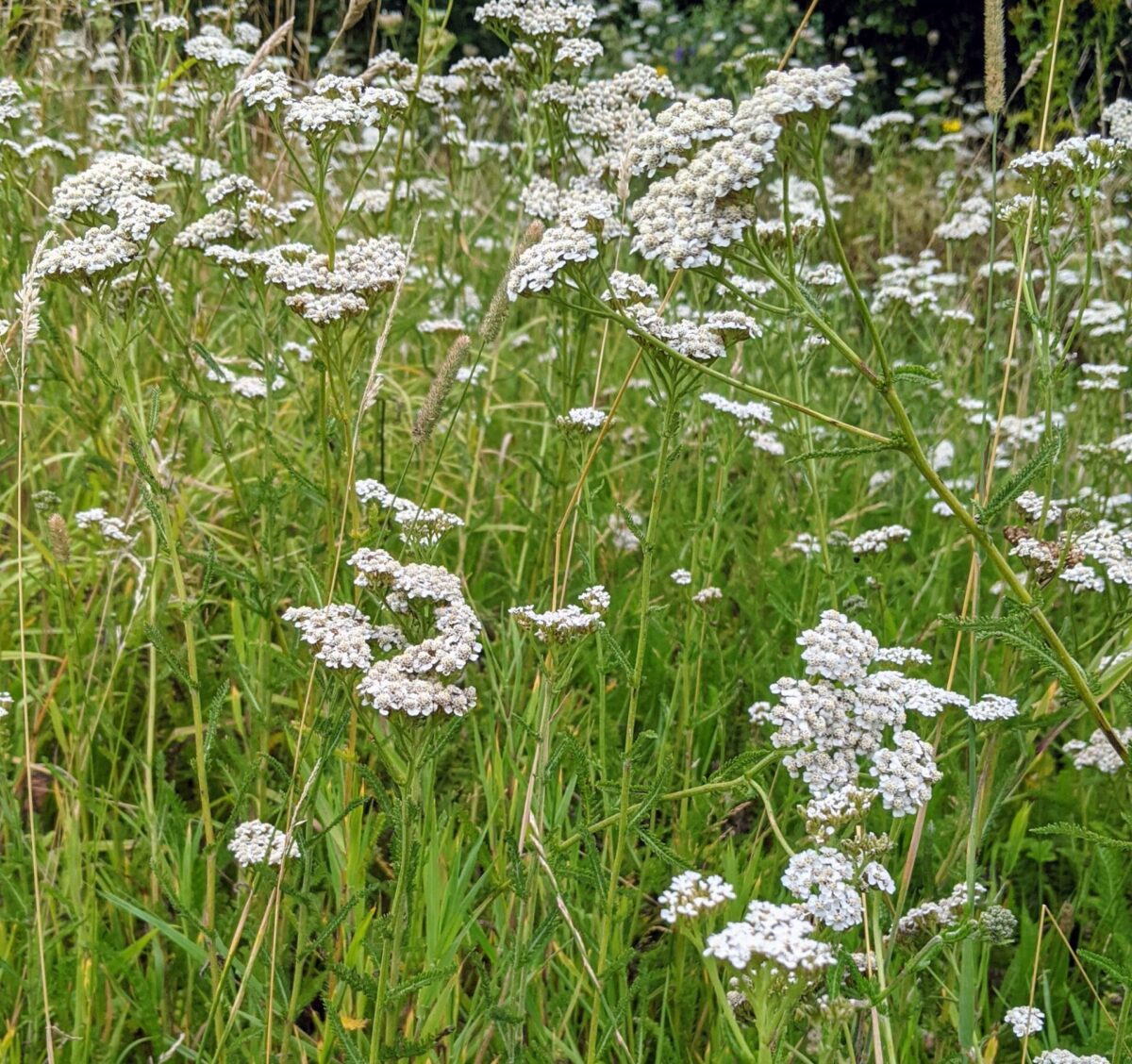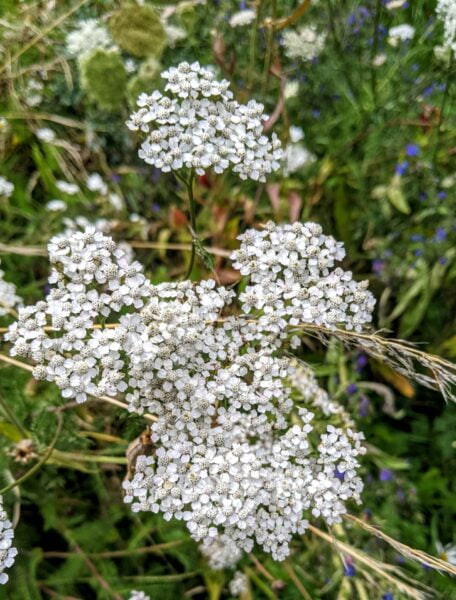Yarrow

Description
Yarrow is a hardy perennial growing to about 3 ft (92 cm) in height. It is a member of the Asteraceae family, with frondy leaves and large panicles of tiny white flowers. It is also known as Soldiers’ Woundwort, Staunch Grass, Old Man’s Mustard, Devil’s Plaything, Nosebleed, Old Man’s Pepper and Devil’s Nettle (because it was believed to be one of the Devil’s favourite plants). In Sweden it is known as Field Hops and has been used to make beer. The French call it Carpenter’s Plant as it is believed to instantly cure wounds caused by edged tools.
Yarrow has been around for about 6000 years. The ancient Greeks called it herba militaris, the military herb. The botanical name “millefolium” comes from the Latin meaning “thousand cuts”, referring to the many cuts of its leaves. The word “Yarrow” derives from the Anglo-Saxon “yearwe”.
Where to find Yarrow in the wild
Yarrow is found in meadows, grasslands hedgerows and woodland clearings. It is also widely distributed throughout the UK and Europe. It flowers from June to as late as November sometimes.
Wildlife Value of Yarrow
Some bird species, such as starlings, use Yarrow to line their nests. It is thought they do so because yarrow may have parasite-killing abilities.

The larvae of many moths feed on Yarrow, for example – Essex Emerald, Lime Speck Pug and Straw Belle, Ruby Tiger, Yarrow Pug, V Pug, Grey Pug, Tawny Speckled Pug, Common Pug, Mullein Wave, Wormwood Pug, Sussex Emerald and several Tortricord moths.Narrow Pug, Narrow-winged pug, Common Pug, Bordered Pug.
Beetles and fly species also favour Yarrow, as does a species of Cuckoo Wasp. Ladybirds and hoverflies are also partial to Yarrow, which makes it a good companion plant in the veg patch as these insects will eat the bugs that are eating your veg!
Folklore Associated with Yarrow
Place an ounce of Yarrow from a young man’s grace under the pillow of the person you want to fall in love with you. Superstition has it that if a girl tickles her nose with Yarrow and its starts to bleed, then her lover is true to her. More alarming is that Yarrow was used to induce nosebleed by twirling it in the nostrils, as nosebleeds were considered good for curing headache, or a promise of success in love:
“Yarroway, yarroway, bear a white blow
If my love love me, my nose will bleed now”
Yarrow was tied to cradles to protect babies from witches. The fifteenth-century Book of Secrets by Magnus claims that if Yarrow juice is smeared on the hands and then the hands plunged into water, fish will be drawn to you. It was a plant dedicated to Satan and so used in charms and spells. If eaten at a wedding feast then the happy couple would remain together in love for at least seven years. It was also made into snuff. It was the first herb held in the baby Jesus’ hand.
Keep a bunch of Yarrow hanging in the tool shed for safety and to protect from thieves. Bind it round the handles of tools in case you cut yourself – you can staunch the blood with it. If you lived in Wales you wouldn’t bring Yarrow indoors for fear of incurring a death in the family. In the Hebrides, a leaf held against the eyes will endow you with second sight. If eaten at a wedding feast, the bride and groom would be in love for seven years. Similarly, bridesmaids would bring Yarrow to weddings for seven years of love. Druids used the plant’s stems to divine the weather. The plant is potent against fairies. Witches believed that placing sprigs of Yarrow in their caps would give them the ability to fly. Yarrow used to be mixed with pig grease to make a healing ointment. The plant has also been used to treat measles and poxes. It was one of the herbs of the “Lancashire Witches”, one of whom used it in divination.
he plant is alleged to have got its Latin name from Achilles, who applied Yarrow to the wounds of his bleeding soldiers. Achilles also appealed to the gods for protection before going into battle. They picked him up by the ankle and immersed him in a vat of Yarrow tea but his ankle remained unprotected – hence the term Achilles heel.
Medicinal and Other Properties of Yarrow
*This is provided for information only and is in no way a prescription for use. Please seek the advice of a qualified herbalist before using, particularly if pregnant or you have other medical conditions*
Yarrow is a good compost activator and fertiliser, and horses like it! Young leaves are edible and nutritious, sometimes used in salads. Its leaves can also be used as a poultice or infused to treat wounds or chewed as a remedy for toothache. Milfoil tea is still drunk in the Orkneys for melancholy. It also makes a good dried flower.
Yarrow tea is good for colds. The flower tops can be made into a weak infusion as a cleanser for oily skin. The essential oil in Yarrow contains azulene, which has anti-inflammatory properties. It increases perspiration, lowers blood pressure and relieves indigestion. The Irish believe it is lucky if sewn inside clothing. Yarrow ointment is good for bleeding piles. Good rabbit and guinea pig food when plants are young.
In ancient China, 50 dried and stripped Yarrow stalks were consulted as an oracle. Yarrow cools fevers, increases circulation, soothes aching muscles and heals mucous membranes. Added to snuff, it was known as Old Man’s Pepper. Pull off a Yarrow leaf with the left hand saying the name of a sick person you wish to cure. Then eat the leaf and the fever in the patient will fall. Yarrow tea was believed to prevent baldness if rinsed in it.
If planted amongst herbs it will strengthen them and make them more disease-resistant. It will also enhance the essential oils of herbs planted near it. Flowers last well in water.


